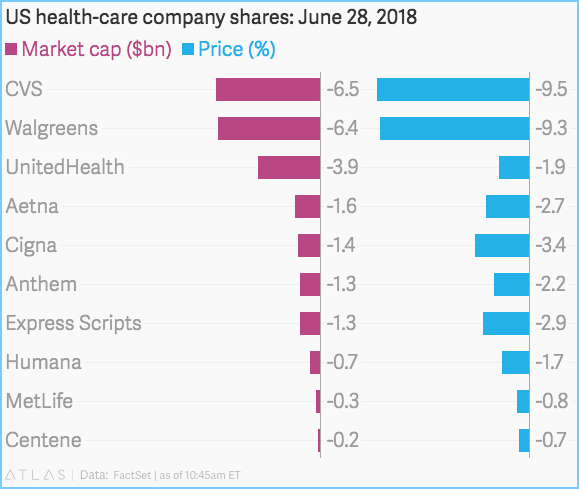💰Quantifying “The Amazon Effect”💰
In Sunday’s Members’-only edition we noted how, unlike certain other retailers that have found themselves in bankruptcy of late, Pier 1 Imports Inc. ($PIR) is almost certainly a victim of Amazon Inc. ($AMZN). Given the relative lack of debt and no private equity overlord, it seems that pundits have as clear-cut an example of “The Amazon Effect” as you can get.
This — coupled with the last few year’s of retail carnage — naturally begs a question about Amazon’s reach and market share.
Luckily, shortly before Christmas, Benedict Evans did a deep dive into Amazon’s business (using 2018 numbers). We’ll summarize it here but it’s worth a read in its entirety.
Discussing sales, Evans writes that in the US:
Amazon sold $77.5bn of products itself,
And also sold another $106bn for third parties,
Giving a total US [Gross Market Value] in round numbers of roughly $184bn.
…$184bn sounds like a big number, but how does that compare to the competition? What market share would that give Amazon?
The simple answer is that the US government gives a number for total ecommerce sales as an economic statistic: in 2018 the number was $522bn. Hence:
Amazon’s first party business had about 15% market share of US ecommerce
The third party business had about 20%
And the total GMV had a 35% share.
Note the distinction he’s making between direct online sales and “third-party seller services.” The latter is Amazon’s “Marketplace,” where Amazon simply serves as an agent handling the logistics for third-party sellers.
Splitting out GMV is important because Amazon isn’t setting the price or choosing the selection for the third party Marketplace. This is especially relevant for any conversation about predatory pricing: Amazon is setting the price directly for 15% of US ecommerce, not 35%. On the other hand, some of those third party products will be competing with products that are sold and priced by Amazon, and setting their own prices accordingly. Life is complicated.
But Amazon doesn’t merely compete with online businesses and so the share numbers above aren’t entirely accurate — particularly in the context of discussions about monopolies and regulation. Amazon does compete, for instance, against physical retailers like Walmart Inc. ($WMT), Target Inc ($TGT) and Barnes & Noble Inc. ($BKS), as just some examples (and increasingly so, it seems, given the improving performance by the former two, especially). For this, you need to add in the effect of Amazon’s limited physical consumer goods stores, i.e., AmazonGo (11 stores), Amazon Books (18 stores), Amazon 4-Star (3 stores), and most importantly, WholeFoods (~470 stores). In 2018, physical stores accounted for $17.2b of net sales (for the sake of comparison, Amazon’s cloud offering, AWS, was $25.6b). And then, he notes, we need to compare the figure against total US retail (excluding auto, gasoline stations, restaurants, bars).
That leaves ‘addressable retail’ (i.e. excluding cars, car parts, gasoline stations, restaurants and bars) of $3.6tr in 2018.
Hence, Amazon US retail revenue of $200bn was about 6% of US addressable retail.
(Incidentally, this means that $522bn total US ecommerce is about 15% of US addressable retail.) (emphasis added)
These are interesting numbers and support, in many respects, PETITION’s long-held position refuting the simplistic view that the proliferation of bankrupted retailers is the result of “The Amazon Effect.” Said another way, The Amazon Effect likely gets way more air time than it deserves. Right now anyway. Indeed, “in the USA in 2018, Amazon was a little less than two thirds of the size of Walmart.”
But:
…of course, Amazon is growing. Its US ecommerce business probably grew 20% in the last year, and so its market share of total and of addressable retail is going up. Hence, you could argue that since ecommerce is clearly going to take over a much larger share of retail, and since Amazon has a large (35-40%) share of ecommerce, Amazon’s strength in ecommerce means it will swallow everything else, even if it’s only at 5-6% today.
And this is to say nothing about how it has used data to sideswipe third-party sellers and promote its own private label brands at their expense — among other shady behavior.
Evans concludes:
I don’t think one can just assume that Amazon’s market share of online sales will be maintained indefinitely in a straight line into the future. The more that ecommerce expands beyond the original commodity categories, the more that we see new and different models and experiences proliferating. Shopify, another platform for online retail, is now at an annual run-rate of $60bn of GMV, up from nothing five years ago.
Of course, people have bet against Amazon in the past and we know how that’s worked out.










